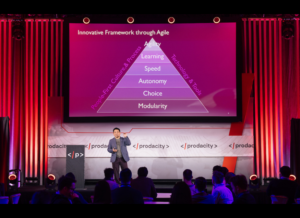Today, too many government software organizations are in crisis. They face soaring expectations for delivering digital solutions, the challenge of understanding a complex and fast-changing array of new technologies and new threats, and must draw from a limited pool of experienced developers, SRE, and SecOps professionals that are ready to execute in modern environments.
What’s worse, technical talent is too often underutilized. On average, we have seen reports that nearly 40% of developer time is wasted on meetings, interruptions, and other cumbersome processes. Add to this the mounting pressure of incidents, emergencies, and shifting priorities, and it’s no wonder why software leaders say that less than 18% of their teams are truly agile.
When engineers can’t flourish, you should expect to see short tenures, delivery delays, and unstable operations. This is especially true in government, where innovation can often be stifled by legacy processes.
Highly Collaborative Teams are More Productive Teams — But the Wrong Tools Can Hold Them Back
What we do know is that teams with tailored collaboration patterns typically and materially outperformed their peers. Far more than video calls and calendars, developer collaboration is focused on thoughtfully integrating technical processes, workflows, and tools to maximize context and productivity, reducing unnecessary interruptions and ensuring alignment across the software development lifecycle.
But the majority of collaboration and prescribed “productivity” products on the market aren’t built to support technical teams. Because of this, they force users to context switch between tools to accomplish tasks. Often, this interrupts the flow of users across collaboration, task management, and developer processes, impeding the ability of engineers to get work done effectively.
Fortunately, the rise of open source has given developers a voice in changing the status quo. Open source platforms are prevalent and popular because they offer developers access to system source code, making the tools easily extensible and customizable, all while preserving the ability to rapidly integrate with other critical tools in their stack. Thousands of technical teams have contributed to open source projects, advancing real-time messaging beyond the limitations of basic messaging, into unified task, project, and workflow management.
By leveraging the right open source platforms, developers can avoid context switching and dramatically accelerate their software organization’s ability to plan, build, and ship software faster and better, all while retaining full control over sensitive data by self hosting. With the right tools like these, engineers and developers can help their organization achieve and transform digital operations.
Increased Complexity in Digital Operations
Many teams were already struggling to achieve efficient collaboration despite multiple tools that purported to solve the problem of aligning technical teams across the myriad of complex R&D processes. With the arrival of the COVID-19 pandemic and the immediate acceleration of remote work and digital transformation, the expectations for digital operations teams have surged.
While virtually every organization is now competing with the ability to build and operate software with increased velocity and quality, too many digital operations teams are buckling under the growing complexity of development toolchains, distributed teams, increased demands for specialization within their functions, knowledge silos, talent shortages, operational bottlenecks, an unprecedented attack surface, and a continuous rise in security risk.
At the same time, the number of applications that will need to be built and operated is exploding. Over 500 million software applications are expected to be built in the next five years. This is with a near-0% unemployment rate amongst software engineers and an expectation of consumer-grade experiences across business tools and applications, and 24/7/365 availability.
Building a Better Future for Digital Operations
So how can we help developers and technical teams move forward? We believe that the first step to mastering and transforming digital operations is to align your teams, tools, and processes across each stage of the development lifecycle – from sprint planning to release to incident management.
Armed with little more than general-purpose collaboration tools built for business users, technical teams are at a significant disadvantage for supporting the complex, fast-changing needs of digital operations at scale. These tools aren’t built for the extensibility, security and bespoke compliance requirements needed to integrate technical teams with the processes and customizations digital operators rely on.
The industry needs a solution to this disconnection. Engineers and developers need a platform built explicitly for digital operations, unifying team communication, task and project management, and workflows into a single point of collaboration. This centralized command center accelerates visibility, alignment and control, and enables teams to operate at the rapid speed of the evolving digital world.
As DevOps teams continue to overcome the challenges of a hybrid workplace and misaligned workflows, the need for this dedicated collaboration platform has become increasingly evident. By breaking down technology and information barriers, stakeholder alignment is also facilitated so that the organizational silos that typically impede digital transformation efforts are no longer a factor.
By making it easier for developers to collaborate, organizations can meet the urgent need and requirement for engineering velocity. For government agencies, meeting this demand will drive not only an accelerated shift to digital government operations, but an increase in overall innovation and quality of software and services for all citizens.
Learn more about Mattermost at www.mattermost.com and download the Mattermost Government Solutions Guide.







